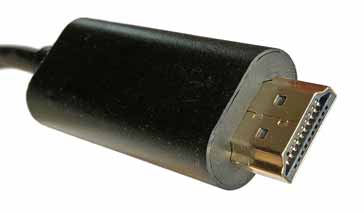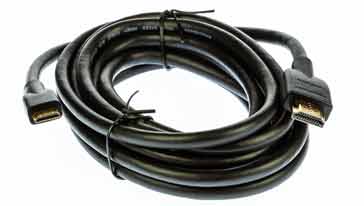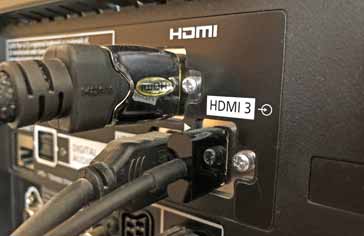What is HDMI High Definition Multi-Media Interface?
HDMI, the high definition multimedia interface is widely used for home & professional audio and video applications.
HDMI Technology Includes:
HDMI - the basics
HDMI versions
HDMI connectors
Pinout / pin connections
HDMI cables
USB C to HDMI
HDMI & DVI
HDMI switch, splitter & matrix - the differences
HDMI extenders
HDMI repeaters
Essential HDMI products
The High-Definition Multimedia Interface, HDMI is an interface that is widely used for audio visual equipment for both domestic and professional applications.
When HDMI was first introduced it offered a level of performance that was much greater than that available previously and since then it has developed to accommodate the latest audio and visual standards.
The HDMI interface is used on many audio visual applications from televisions to computer monitors and home entertainment systems to video displays and much more.

The HDMI interface has a far higher specification than previous interconnection systems that were used. As a result HDMI is used for HD television systems, Blu-Ray DVD players, game consoles and very many more items. HDMI is also used for photography and a mini-HDMI connector is incorporated into many camcorders, DSLRs and many other forms of camera. There is even a micro-HDMI connector intended for mobile devices like phones, etc.
The performance of the HDMI interface means that the system is well suited to the very high data rates that now need to be transferred between units within home television, video and theatre systems.
There have been many upgrades and developments to the HDMI standard including some new smaller HDMI connectors since its initial release. However, the original connector is still the most widely used, allowing for physical compatibility in addition to the electrical backward compatibility.
HDMI usage basics
Physically the HDMI system uses connectors like any other cable based scheme. In fact HDMI may look a little like USB to the untrained eye having rectangular plugs and sockets with cables between.
The connectors can be either male of female dependent upon their usage and position.

The convention is to use a female connector or socket where any signal or power is supplied. The thinking is that a female connector or socket is harder to short accidentally than a plug where the pins may be accessible.
For HDMI, signals travel in both directions, and also to simplify the interconnections, sockets tend to be used on equipments and plugs are found on cables.
To prevent accidental shorting, the plugs are designed to prevent accidental contact.
Development of HDMI
Prior to HDMI, interconnectivity for video and the like was not easy. SCART was used for many TV systems and the old SCART cables and connectors were large and unwieldy. They were also unreliable, connectors often needing to be "wiggled" to get a good connection. They were also prone to falling out. Also the cables were very thick and often difficult to route in audio video systems.
Another approach was to use DVI - this was a video-only connector that was better suited to its original use in computer monitors.
Another alternative was to use cables for the individual video components, but these could require a number of cables to be used and more were needed if audio was also required.
To overcome these issues and provide a single cable system and interface for all requirements, HDMI was developed. The system was developed by a consortium of interested industry companies in 2002.
Development of the first HDMI standard was fast and the first consumer devices using HDMI started to appear in late 2003. HDMI began to appear on consumer HDTVs in 2004 and camcorders and digital still cameras in 2006.
Various updates to the standard were launched to enhance its performance and to ensure that it met the growing requirements for audio visual technology.
In order to ensure that HDMI was developed in accordance with the needs of the users and industry, an organisation to develop and manage the standard was launched on 25 October 2011. Known as the HDMI Forum, it was established by the HDMI founders to create an open organisation to represent the interests of the interested companies.
HDMI performance
The HDMI standard has a number of key features that are summarised in the table below.
| Salient HDMI Features & Specifications | |
|---|---|
| Parameter | HDMI Details |
| Standard management | HDMI Forum |
| HDMI Forum | 7 Founders, 80+ members, 1700+ adopters |
| Initial introduction | 2002 |
| Connector types | A, B, C, D, & E Types A, C, & D 19 pins, Type B 29pins |
| Connector measurements | Width: 13.9 mm (type A), 10.42 mm (type C), 6.4 mm (type D) Height: 4.45 mm (type A), 2.42 mm (type C), 2.8 mm (type D) |
| Hot pluggable | Yes |
| Video signal | Maximum resolution limited by available bandwidth |
| Audio signal | LPCM, Dolby Digital, DTS, DVD-Audio, Dolby Digital Plus, Dolby TrueHD, DTS-HD High Resolution Audio, DTS-HD Master Audio, MPCM, DSD, DST, Dolby Atmos, DTS:X |
| Max bitrate | Up to 48 Gbps in HDMI 2.1 |
| Data protocol | TMDS, Transition-Minimized Differential Signalling |

HDMI versions
As technology has developed, so too has HDMI. It has had to accommodate significant changes to video standards with the moves from HDMI being aimed at DVD playback to the latest standard that can accommodate 4K video data transfer for video gaming and other video applications.
The HDMI versions went from a 1 to 2 when control passed from the original HDMI Licensing, LLC to the HDMI Forum, and industry body made up from members with interests in moving the standards forwards.
It is also helpful to have a basic understanding of the different HDMI versions when buying cables and generally checking compatibility and the quality that may be possible from a given system.
HDMI connectors
A number of HDMI connectors have been defined for use with the HDMI standard. The basic format has not changed over the years making interconnection of devise using HDMI very easy.

There are five types of HDMI connector. These are designated A to E. Of these the Type A is most widely used, and the Type B which can be used for dual link operation has not been incorporated on any products yet.
In addition to this Type C connectors have a mini format, and Type D is a micro format. Type E is used for automotive applications and has an anti-vibration mounting to prevent it becoming disconnected.
Use with other standards
HDMI is a particularly flexible interface, and although ther are many other forms of interface in use, it is possible to use HDMI inputs and outputs and connect them directly to other interface formats, although an adapter or special cable may be required.
- HDMI & DVI: HDMI was originally developed to replace the DVI interface and connector that is still found on many computer monitors and other items of video display hardware. However DVI is a video-only interface, and HDMI can carry both audio and video signals at the same time. However HDMI is electrically compatible with the DVI interface.
It is possible to interface HDMI and DVI, and this can be accomplished by purchasing an HDMI-DVI connector. Users are then able to run HDMI cables out from DVI sockets on older hardware and display the resulting image perfectly on more modern screens or receivers that lack their own DVI port.
In a similar way, HDMI audio connectors can also be used to convey just the sound signals from devices with older-style component audio ports if the right adaptor is used. - HDMI & USB: An increasing number of computers and devices are using USB, and in particular USB C as the standard interface. It is possible to buy USB to HDMI cables and adaptors and use one to connect to the other.
In order to be able to provide the interface between USB-C and HDMI, the HDMI uses what is termed an Alternative Mode, AM, which enables the two different interfaces to communicate.
Read more about . . . . USB-C to HDMI.
Check out the Electronics Notes: Essential HDMI Items List.
HDMI is now a very well established standard and used on most new items of audio visual equipment from televisions to recorders and DVD players and computers to displays and many other items. Being regularly updated the standard will remain relevant for many years to come.
 Written by Ian Poole .
Written by Ian Poole .
Experienced electronics engineer and author.
More Audio Video Topics:
HDMI
SCART
DisplayPort
DVI
Loudspeaker technology
Headphones & earphones
Bluetooth speakers
Stereo sound
Microphones
Audio compact cassettes
Vinyl record technology
Digital radio
DVB television
Return to Audio / Video menu . . .



